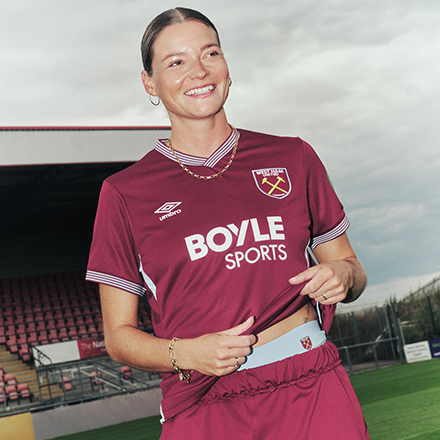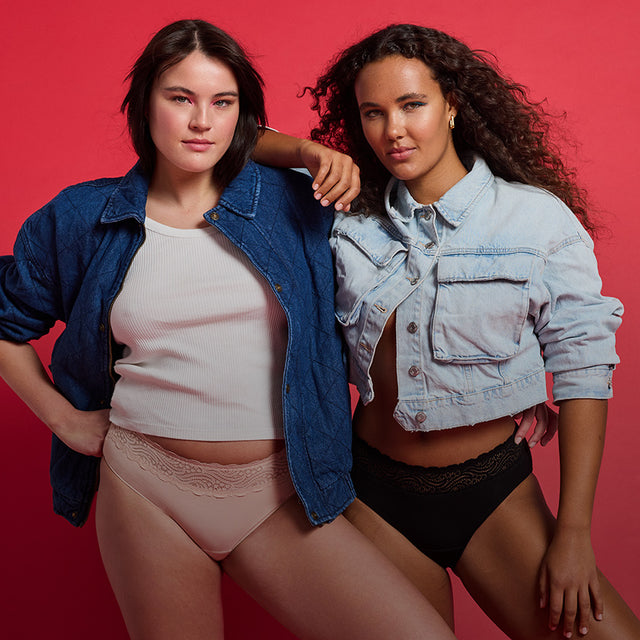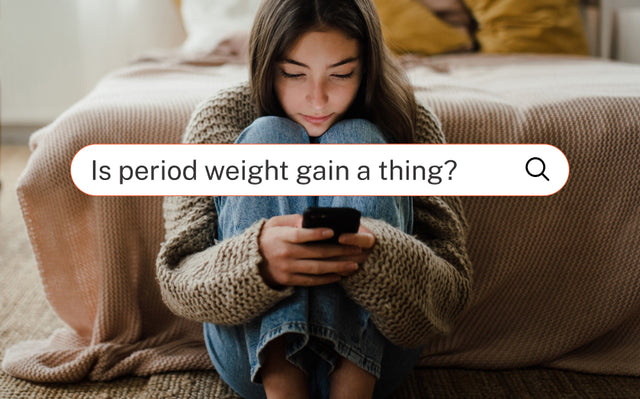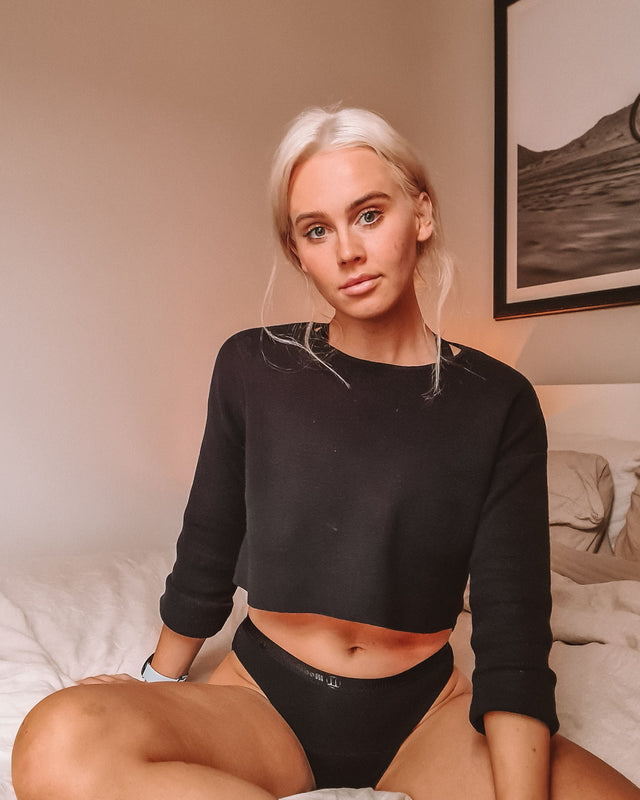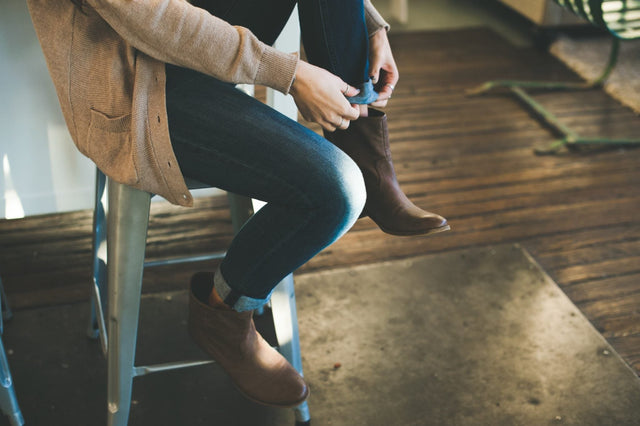Your first period: everything you’re too scared to Google
Getting your first period is a big deal. It’s a milestone moment and a sign that your body is shifting gears to do some pretty amazing things. But let’s be real – menstruation can be confusing and overwhelming, especially when you’re not entirely sure about what’s going on down there.
Whether your period has arrived or not, you probably have a lot of questions. Save yourself the incognito search because this article covers everything you’re too scared to Google, and more.
Let’s dig straight in to answer some of the big questions.
Why is my period blood brown on the first day?
Menstrual blood can come in all sorts of colours, from pink and bright red to brown, dark red and even black. Period blood is brown on the first day because it’s older blood or black blood, which has been oxidised through exposure to oxygen. Blood colour can change during your cycle and isn’t usually anything to worry about.
Here’s a handy guide to help you understand the colour changes:
- Pink blood is usually seen at the beginning of your period and is a mix of fresh blood and vaginal discharge. The colour pink tends to show up with lighter periods.
- Bright red blood is fresh blood. But don’t worry – it’s a sign that your uterus is actively shedding, and that’s a good thing.
- Dark red blood is blood that’s been in your vagina for a while, and it’s susceptible to forming clots (covered below).
- Brown or black blood has been inside your body for even longer. The shade can change when it mixes with oxygen and discharge.
And then there’s the consistency
It’s not just blood colour that can change during your period. The texture can vary too. You might experience thin, watery blood or thicker, stickier discharge, and you may even begin seeing clots.
Passing clots might sound scary, but they’re generally small and harmless for most people. If you’re worried, it’s helpful to assess their size. Anything bigger than a grape warrants a chat with your doctor.
And now we’ve got bad blood …
Not the Tay Tay relationship kind, but the stuff that makes you wonder if something else is up.
Yes – period blood can vary in colour and consistency quite a bit. That’s okay and considered to be fairly common. But if you begin to notice unusual changes in your cycle or experience any of the following, see your GP.
Here’s what you need to keep an eye out for:
- Severe cramping during your cycle
- Dizziness, feeling lightheaded or extreme fatigue
- Chest pain or nausea and vomiting that accompany your periods
- Spotting or bleeding between cycles
- Funky or smelly vaginal discharge
Other concerns to flag with a parent or doctor include heavy periods (aka, changing pads or tampons every 2 hours) and cycles that last longer than 7 days.
Is period weight gain a thing?
When your period is on its way, you might notice a small rise on the scales, but this is usually temporary.
Some people who menstruate experience no weight gain. But for others, period weight gain starts a few days before each period – about the same time those delightful food cravings and mood changes decide to take over the shop.
To understand how period weight gain works, we spoke with Dr Kavipriya Soma, an expert from the Athena Women’s Clinic. She explained that period-related weight gain is linked to a spike in the hormone progesterone, which helps to thicken the uterus lining in preparation for pregnancy.
“Progesterone helps the body retain fluid and slows down bowel movements,” she explains, “which can make you feel bloated and alter your weight.
“The other thing that happens is that blood flow to the pelvis increases, and the pelvic area becomes quite heavy when your body prepares for a period. This can cause pelvic congestion, which can also make you feel bloated and can impact your bowel movements.”
The good news is that you can tackle fluid retention and sluggish bowels by:
- Staying hydrated – permission to drink more water
- Eating healthy and nutritious foods
- Taking a magnesium or PMS support supplement (check with your doctor first)
- Moving your body with regular exercise
- Reducing salt and caffeine intake
Why did I get my first period but not my second?
It happens. If you got your first period but not your second, or you’ve noticed that your period cycle is irregular, try not to worry. The first few years of menstruation can cause irregular periods, so it’s a bit of a journey.
Menstruation cycles can range from 21 to 40 days. To work out how long your cycle is, work out the time from the first day one period to the first day of your next period.
Although the average cycle is around 28 days, some people who menstruate experience irregular periods that can show up at any time. And they do. So the best piece of advice is to be prepared.
A missed, late or stopped period can be caused by many things, including:
- Pregnancy
- Stress
- Taking the contraceptive pill
- Sudden weight loss or being overweight
- Doing too much exercise
- Polycystic ovary syndrome (PCOS)
- Menopause (that’s down the track for you)
Periods can also sometimes stop (or be disturbed) due to medical conditions such as an overactive thyroid.
“The most common cause of irregular periods in women of reproductive age is something called polycystic ovarian syndrome,” says Dr Soma. “Normal variations can happen in an average person’s cycle, so your period can be 2 days early or 3 days late.”
She suggests keeping a cycle diary so you know what your average cycle length is. If pen and paper aren’t your thing, try using a period-tracking app like Flo.
Can you get your period in your sleep?
Put simply, yes. You can get your period in your sleep or during the day. There’s really no telling when it will arrive. Studies show that 70.4% of people who menstruate get their period at night or in the first 4 hours after rising compared to later in the day.
Dr Soma says that while your period can begin at any time, you’ll usually get some forewarning in the form of cramps or discharge. The best thing to do is to listen to your body and look out for these common premenstrual symptoms (PMS):
- Cramps. Discomfort, pressure or cramping in your lower stomach can be a sign that your period is on its way.
- Mood Swings. One minute you’re laughing at a TikTok, the next minute you’re crying over a bank ad. Unexpected emotional changes can be your period knocking on the door.
- Food Cravings. Got a sudden hankering for chocolate, chips and anything else that’s brightly packaged? Hunger and cravings are good telltale signs of what’s to come.
- Tiredness. Slept for 8 hours but can’t shake off the sleepiness? PMS fatigue could be to blame.
- Bloating. If you’re feeling a bit puffy or bloated like you’ve just finished Christmas lunch, your period could be close.
- Discharge. Noticing discharge before your first period or any other time can be a sign that your period is on its way.
Do your boobs get bigger on your period?
Yes, your boobs can feel bigger, sore, sensitive and lumpy around the time of your period. This is thanks to the rise and fall of hormones including estrogen and progesterone. While estrogen can enlarge the breast ducts, progesterone can cause milk glands to swell, leaving you with the perfect potion for tender breasts.
But the good news? Symptoms usually subside when your period ends, so the sensitivity and tenderness fade away in due time.
Period power: get prepped with the right products
When it comes to your period, it’s all about finding what works best for you. There’s a lot of variety out there when it comes to choosing period products, and sometimes it can take a bit of mixing and matching, depending on what’s happening each day.
If you’re looking for leak-proof comfortable period care, and you’re conscious of the environmental impact, period underwear could be your new forever besties. Our teen period products are high-tech but ridiculously easy to use, and they’ll protect you from leaks on all those occasions when you won’t see it coming.
Available in cute, comfy styles that can absorb regular or heavy flows, our period underwear means no pads, no tampons, no waste and pretty much no worries.
To slay your way through every period, here’s what we recommend.
Hipster Bikini
With two different absobency levels, our Hipster Bikini has your back all day and night, with minimum fuss, no matter what your flow is. [H3]
Hipster Boyshort
Great for wearing under uniforms, skirts, dresses and sports kits, and catering for two different absorbency levels, our Hipster Boyshort Maxi and Hipster Boyshort Moderate-Heavy are the leak-proof staples you won’t be able to live without.
Teen 7 Pack
Get set up with our Teen 7 Pack, a bundle of period protection that mixes bikini briefs with boyshorts to keep you comfy and dry all week long. You can personalise your bundle too!
Feeling period-ready?
You’ve got this! Now that you know how to decode period blood, manage PMS symptoms and choose menstrual products that feel right for you. So go forth and embrace the power of being prepared for your first period.
And remember, if you have any concerns or questions about your period, speak with a trusted adult or your doctor.


